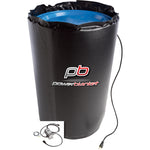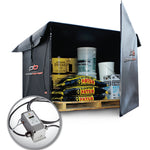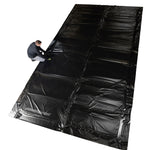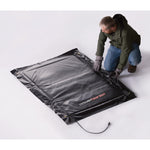You have no items in your shopping cart.
Mastering the Warmth: Tailored Heating Solutions for Optimal Anaerobic Digester Design & Function
Article At-a-Glance
What Are Digester Heaters and How Do They Optimize Anaerobic Digestion?
Digester heaters are specialized heating systems, such as heat exchangers and external heaters, designed to maintain optimal temperatures within anaerobic digesters—typically between 95°F and 150°F—ensuring efficient microbial digestion and maximizing biogas production.
Key Takeaways
- Maintain Optimal Temperatures: Digester heaters are crucial for sustaining the ideal temperature range (95°F to 150°F) necessary for efficient microbial activity and biogas production in anaerobic digesters.
- Explore Heating Solutions: Various heating systems, including heat exchangers, boilers, and external heaters, are available to either recover or supplement heat, ensuring consistent temperature regulation within digesters.
- Understand Design Impacts: The design of anaerobic digesters, such as Continuous Stirred-Tank Reactors (CSTR) and Plug Flow Reactors, influences temperature distribution and overall digestion efficiency.
- Address Temperature Challenges: Custom heating solutions are essential for overcoming temperature fluctuations, especially in colder climates, to prevent reduced gas production and potential digester failures.
- Optimize with Custom Solutions: Tailored heating systems enhance biogas production, reduce energy costs, and improve the sustainability of wastewater treatment processes by providing precise temperature control.
A fine-tuned anaerobic digester system can maximize the amount of helpful byproducts in a wastewater treatment plant and reduce harmful emissions. Operators can achieve peak effectiveness with custom heating solutions.
Process Heating Solutions for Anaerobic Digesters
Wastewater treatment is an essential process that ensures the cleanliness and safety of our environment. At the heart of this crucial operation are anaerobic digesters, specialized tanks where organic waste undergoes a natural transformation, converting it into biogas and valuable byproducts. The key to this transformation lies in maintaining the optimal temperature within these digesters, which is critical for ensuring the efficiency and effectiveness of the digestion process.
What is anaerobic digestion?
Anaerobic digestion is a biological process that relies on the activity of microorganisms to break down organic materials. The absence of oxygen is a defining characteristic of this process. Bacteria play a pivotal role in anaerobic digestion by converting organic matter into biogas, primarily methane and carbon dioxide. This biogas can be used as an energy source, while the digested material becomes a valuable resource for use as fertilizers.
To fully appreciate the significance of temperature control in anaerobic digestion, it's important to understand the basics of how anaerobic digesters work.

Anaerobic digestion occurs in different stages, each characterized by a specific group of bacteria with distinct functions. The primary stages are:
- Hydrolysis: In this initial stage, complex organic compounds are broken down into simpler substances, such as carbohydrates, fats, and proteins.
- Acidogenesis: During this stage, acid-forming bacteria further break down the simpler compounds, producing organic acids and additional compounds.
- Acetogenesis: Acetic acid and other volatile fatty acids are produced in this phase.
- Methanogenesis: Methane-forming bacteria, known as methanogens, convert these volatile acids into biogas, mainly methane and carbon dioxide. Methane is often burned off or stored for utility use (such as natural gas for home heating or vehicle fuel), while carbon dioxide is usually released into the air.
Each of these stages requires tanks of enormous sizes that hold the material being broken down. These tanks keep the material warm while it is being processed. The regularity of the internal tank temperature directly contributes to the efficiency of the digester.
Delving into digester design
Anaerobic digesters come in various designs, and each design type has its own advantages and disadvantages. The design of the digester can impact the efficiency and effectiveness of the digestion process. For example, the size and shape of the digester can affect the temperature distribution. The type of mixing system can also affect the digestion process.
Common digester designs include Continuous Stirred-Tank Reactors (CSTR), Plug Flow Reactors, and Up-flow Anaerobic Sludge Blanket (UASB) reactors, among others. The choice of design significantly impacts the efficiency and effectiveness of the digestion process.

Each of these reactors serves to take on a different approach to digestion, depending on the specific needs of the wastewater treatment facility. Continuous Stirred-Tank Reactors (CSTR) are well-mixed systems that offer a consistent environment for bacteria. Plug Flow Reactors, on the other hand, allow waste to flow through the digester in a linear fashion, facilitating different conditions in various sections. UASB reactors utilize a sludge blanket to separate solids from liquids and provide a concentrated environment for methane-producing bacteria.
The pivotal role of temperature
Temperature is a critical factor in anaerobic digestion. The process can occur at different temperature ranges, each with its own benefits and challenges. Mesophilic digestion occurs at temperatures between 95°F and 115°F (35°C to 45°C), while thermophilic digestion operates at higher temperatures, typically around 135°F to 150°F (55°C to 65°C).
Mesophilic digestion is less sensitive to temperature fluctuations and is often more stable, but it has a slower reaction rate. Thermophilic digestion, while faster and capable of higher gas production, is more susceptible to temperature changes.
Challenges in temperature regulation
Maintaining the ideal temperature in anaerobic digesters can be challenging, especially in regions with cold climates. Temperature fluctuations can disrupt bacterial activity, leading to reduced gas production, longer digestion times, and even potential digester failures. If the temperature gets too high, the bacteria can be killed, which can lead to reduced biogas production and potential digester failure. These issues can significantly impact the overall efficiency of the wastewater treatment process.
Custom heating solutions: a necessity, not a luxury
To overcome these challenges and ensure the consistent temperature regulation required for optimal anaerobic digestion, custom heating solutions are essential. These solutions are specifically tailored to meet the unique needs of individual wastewater treatment plants and their digester designs. The benefits of custom heating solutions include:
- Consistent Temperature Maintenance: Custom heating solutions are designed to maintain a precise and stable temperature range, ensuring optimal conditions for bacterial activity.
- Improved Gas Production: By maintaining the ideal temperature, custom heating solutions can significantly enhance biogas production, increasing energy output.
- Reduced Energy Costs: Custom heating solutions are energy-efficient, minimizing energy consumption and reducing operational costs.
Tailored designs for digester tanks
In the world of wastewater treatment, anaerobic digesters play a pivotal role in converting organic waste into valuable resources. Temperature control within these digesters is of utmost importance to ensure optimal digestion processes. Temperature fluctuations can disrupt bacterial activity, leading to reduced gas production and potential digester failures.
Custom heating solutions, such as heat trace for digester heating, can be designed to fit specific digester designs and sizes, addressing the unique requirements of each wastewater treatment plant. They offer consistent temperature maintenance, improved gas production, and reduced energy costs, making them a smart investment for wastewater treatment plants. Heating equipment can also help with storage solutions, such as tote heaters for caustic soda and other chemicals used in digesters. This tailored approach offers several advantages over generic heating options, including:
- Optimal Performance: Custom heating solutions are optimized for the specific digester design, ensuring the best possible results in terms of gas production and waste digestion.
- Energy Efficiency: These solutions are designed to maximize energy efficiency, reducing operational costs over time.
- Environmental Sustainability: Tailored temperature control solutions contribute to a more sustainable wastewater treatment process by maximizing biogas production and reducing waste.

Investing in custom heating solutions not only enhances the efficiency of the anaerobic digestion process but also contributes to a more sustainable and environmentally friendly wastewater treatment operation. Wastewater treatment plants should consider the benefits of custom heating solutions and explore the available options tailored to their specific needs.
Maximize your wastewater treatment's effectiveness, even in the chilliest conditions. Don't compromise on performance – discover custom solutions designed for your specific needs.
Heat Authority knows your needs
We encourage wastewater treatment plant operators and managers to explore the advantages of custom heating solutions for their anaerobic digesters. Contact Heat Authority today to discuss how our tailored heating solutions can optimize your digester's performance and help you achieve your wastewater treatment standards. Don't let temperature fluctuations hold back your operations; invest in a custom heating solution and make a positive impact on your wastewater treatment efficiency and sustainability.













